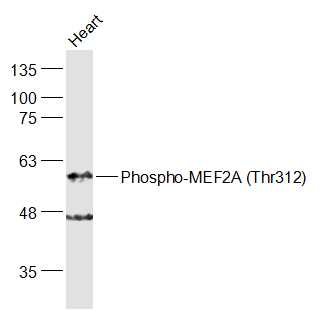
Rabbit Anti-Phospho-MEF2A (Thr312)antibody
MEF2A (phospho T312); p-MEF2A (phospho T312); MEF2A (Phospho Thr312); MEF2A (Phospho T312); MEF2A (Phospho-Thr312); myocyte enhancer-binding factor 2; ADCAD1; MADS box transcription enhancer factor 2 polypeptide A; MADS box transcription enhancer factor 2
View History [Clear]
Details
Product Name Phospho-MEF2A (Thr312) Chinese Name 磷酸化肌细胞增强因子2抗体 Alias MEF2A (phospho T312); p-MEF2A (phospho T312); MEF2A (Phospho Thr312); MEF2A (Phospho T312); MEF2A (Phospho-Thr312); myocyte enhancer-binding factor 2; ADCAD1; MADS box transcription enhancer factor 2 polypeptide A; MADS box transcription enhancer factor 2, polypeptide A (myocyte enhancer factor 2A); MEF 2A; MEF2; MEF2A; Myocyte enhancer factor 2A; RSRFC4; RSRFC9; Serum response factor like protein 1. Product Type Phosphorylated anti Research Area Cell biology immunology transcriptional regulatory factor Immunogen Species Rabbit Clonality Polyclonal React Species Mouse, (predicted: Human, Rat, Dog, Cow, Horse, Rabbit, ) Applications WB=1:500-2000 ELISA=1:5000-10000 IHC-P=1:100-500 IHC-F=1:100-500 IF=1:100-500 (Paraffin sections need antigen repair)
not yet tested in other applications.
optimal dilutions/concentrations should be determined by the end user.Theoretical molecular weight 54kDa Cellular localization The nucleus Form Liquid Concentration 1mg/ml immunogen KLH conjugated synthesised phosphopeptide derived from human MEF2A around the phosphorylation site of Thr312: LA(p-T)PV Lsotype IgG Purification affinity purified by Protein A Buffer Solution 0.01M TBS(pH7.4) with 1% BSA, 0.03% Proclin300 and 50% Glycerol. Storage Shipped at 4℃. Store at -20 °C for one year. Avoid repeated freeze/thaw cycles. Attention This product as supplied is intended for research use only, not for use in human, therapeutic or diagnostic applications. PubMed PubMed Product Detail The process of differentiation from mesodermal precursor cells to myoblasts has led to the discovery of a variety of tissue-specific factors that regulate muscle gene expression. The myogenic basic helix-loop-helix proteins, including myoD (MIM 159970), myogenin (MIM 159980), MYF5 (MIM 159990), and MRF4 (MIM 159991) are one class of identified factors. A second family of DNA binding regulatory proteins is the myocyte-specific enhancer factor-2 (MEF2) family. Each of these proteins binds to the MEF2 target DNA sequence present in the regulatory regions of many, if not all, muscle-specific genes. The MEF2 genes are members of the MADS gene family (named for the yeast mating type-specific transcription factor MCM1, the plant homeotic genes 'agamous' and 'deficiens' and the human serum response factor SRF (MIM 600589)), a family that also includes several homeotic genes and other transcription factors, all of which share a conserved DNA-binding domain.
MEF2A belongs to a family of DNA binding regulatory proteins. The MEF2 family of transcription factors is highly expressed in the brain when neurons undergo dendritic maturation and synapse formation. MEF2A is especially abundant in granule neurons of the cerebellar cortex throughout the period of synaptogenesis. MEF2A also has key roles in cardiac and skeletal muscle development.
Function:
Transcriptional activator which binds specifically to the MEF2 element, 5'-YTA[AT](4)TAR-3', found in numerous muscle-specific genes. Also involved in the activation of numerous growth factor- and stress-induced genes. Mediates cellular functions not only in skeletal and cardiac muscle development, but also in neuronal differentiation and survival. Plays diverse roles in the control of cell growth, survival and apoptosis via p38 MAPK signaling in muscle-specific and/or growth factor-related transcription. In cerebellar granule neurons, phosphorylated and sumoylated MEF2A represses transcription of NUR77 promoting synaptic differentiation.
Subunit:
Binds DNA as a homo- or heterodimer. Dimerizes with MEF2D. Interacts with HDAC7 (By similarity). Interacts with PIAS1; the interaction enhances sumoylation. Interacts with HDAC4, HDAC9 and SLC2A4RG. Interacts (via the N-terminal) with MAPK7; the interaction results in the phosphorylation and transcriptional activity of MEF2A.
Subcellular Location:
Nucleus.
Tissue Specificity:
Isoform MEF2 and isoform MEFA are expressed only in skeletal and cardiac muscle and in the brain. Isoform RSRFC4 and isoform RSRFC9 are expressed in all tissues examined.
Post-translational modifications:
Constitutive phosphorylation on Ser-408 promotes Lys-403 sumoylation thus preventing acetylation at this site. Dephosphorylation on Ser-408 by PPP3CA upon neuron depolarization promotes a switch from sumoylation to acetylation on residue Lys-403 leading to inhibition of dendrite claw differentiation. Phosphorylation on Thr-312 and Thr-319 are the main sites involved in p38 MAPK signaling and activate transcription. Phosphorylated on these sites by MAPK14/p38alpha and MAPK11/p38beta, but not by MAPK13/p38delta nor by MAPK12/p38gamma. Phosphorylation on Ser-408 by CDK5 induced by neurotoxicity inhibits MEF2A transcriptional activation leading to apoptosis of cortical neurons. Phosphorylation on Thr-312, Thr-319 and Ser-355 can be induced by EGF.
Sumoylation on Lys-403 is enhanced by PIAS1 and represses transcriptional activity. Phosphorylation on Ser-408 is required for sumoylation. Has no effect on nuclear location nor on DNA binding. Sumoylated with SUMO1 and, to a lesser extent with SUMO2 and SUMO3. PIASx facilitates sumoylation in postsynaptic dendrites in the cerebellar cortex and promotes their morphogenesis (By similarity).
Acetylation on Lys-403 activates transcriptional activity. Acetylated by p300 on several sites in diffentiating myocytes. Acetylation on Lys-4 increases DNA binding and transactivation (By similarity). Hyperacetylation by p300 leads to enhanced cardiac myocyte growth and heart failure.
Proteolytically cleaved in cerebellar granule neurons on several sites by caspase 3 and caspase 7 following neurotoxicity. Preferentially cleaves the CDK5-mediated hyperphosphorylated form which leads to neuron apoptosis and transcriptional inactivation
DISEASE:
Defects in MEF2A are a cause of coronary artery disease, autosomal dominant, type 1 (ADCAD1)[MIM:608320]. A common heart disease characterized by reduced or absent blood flow in one or more of the arteries that encircle and supply the heart. Its most important complication is acute myocardial infarction.
Similarity:
Belongs to the MEF2 family.
Contains 1 MADS-box domain.
Contains 1 Mef2-type DNA-binding domain.
SWISS:
Q02078
Gene ID:
4205
Database links:Entrez Gene: 4205 Human
Entrez Gene: 17258 Mouse
Omim: 600660 Human
SwissProt: Q02078 Human
SwissProt: Q60929 Mouse
Unigene: 268675 Human
Unigene: 132788 Mouse
Unigene: 426509 Mouse
Unigene: 466976 Mouse
Unigene: 162435 Rat
transcriptional regulatory factor(Transcriptin Regulators)
MEF2是一种主要存在于肌细胞的转录因子,近来研究发现他也存在于肝脏,并且其表达及活性增加可能激活HSC,提高Ⅰ型胶原启动子的活性及刺激HSC的增生. 因此,MEF2可能在肝纤维化的发生,发展中发挥着重要作用。Product Picture
References (0)
No References
Bought notes(bought amounts latest0)
No one bought this product
User Comment(Total0User Comment Num)
- No comment



 +86 571 56623320
+86 571 56623320
 +86 18668110335
+86 18668110335

